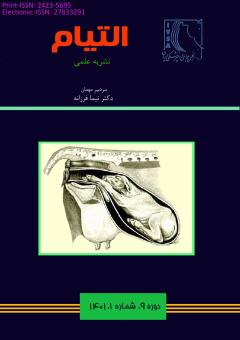احیا و مراقبت از گوساله¬های نوزاد
محورهای موضوعی : سایر علوم وابسته
فائزه وقارسیدین
1
,
نیما فرزانه
2
![]()
1 - دانشجو، گروه علوم درمانگاهی، دانشکده دامپزشکی، دانشگاه فردوسی، مشهد
2 - استاد، گروه علوم درمانگاهی، دانشکده دامپزشکی، دانشگاه فردوسی مشهد
کلید واژه: احیای گوساله, گوساله ی نوزاد, سخت زایی,
چکیده مقاله :
دوره حوالی تولد پرخطرترین دوره در زندگی همه حیوانات است. مرگ و میر دوره حوالی تولد گوساله در 48 ساعت اول زندگی بین 3 تا 3/10 درصد برآورد شده است. بیش از 60 درصد از تولیدکنندگان گزارش کردهاند که بیشتر مرگ و میر گوسالههای آنها در بدو تولد اتفاق میافتد. علل اصلی مرگ و میر دوره حوالی تولد به ترتیب اهمیت، اسیدوز تنفسی و متابولیک، ترومای حین زایمان، هیپوگلوبولینمی، عفونت و کمبودهای مادرزادی و امفالوفلبیت هستند. حدود 90 درصد گوسالههایی که در دوره حوالی تولد میمیرند زنده متولد می شوند و بسیاری از این تلفات قابل پیشگیری است. مدیریت گوسالههای تازه به دنیا آمده از طریق اجرای پروتکلهای ساده که راهبردهای مناسبی را درسطح گله و روشهای صحیحی که بصورت انفرادی ارائه میدهند به بهترین شکل قابل دستیابی هستند. این پروتکل ها مدیریت گاوها درحوالی زایش، در زمان زایش (پایش راحتی زایمان و تشخیص و مداخله در سختزایی) و مدیریت گوساله تازه به دنیا آمده را پوشش می دهند. بنابراین بسیار ضروری است که ارزیابی سریع و مراقبت از گوساله جهت اطمینان از سلامت و زندهمانی و جلوگیری از خسارات اقتصادی ناشی از مرگ در حوالی تولد صورت بگیرد.
The perinatal¬ period is the most perilous in the life of all animals. Perinatal calf mortality in the first 48 hours of life has been estimated to be between 3 and 10.3%. More than 60% of producers have reported¬ that most of their calf mortality occurs at birth. The main causes of perinatal morbidity and mortality are¬, in descending order of importance¬, combined respiratory and metabolic acidosis¬, parturient trauma, hypoglobulinemia, congenital infections and deficiencies, and omphalophlebitis. Some¬ 90% of calves that die in the perinatal period were alive¬ at the start of calving, and so much of this loss is preventable. Management of the newborn¬ dairy calf is best achieved through implementation of simple protocols that document¬ the correct strategies to be followed at the herd level and the correct procedures to be performed¬ at the individual animal level. These protocols cover management of the prepartum cow, management of calving (monitoring of eutocia and detection and management¬ of dystocia)¬, and newborn calf care. Therefore, it is imperative to provide immediate evaluation and care of newborn calves to ensure calf survival and health and prevent economic losses¬ associated with perinatal¬ mortality.
1. McGuirk, S.M., Management of dairy calves from birth to weaning. Dairy Production Medicine, 2011: p. 175-193.
2. Mee, J., Bovine Neonatal Survival Is Improvement Possible. WCDS Advances in Dairy Technology, 2011. 23: p. 161-174.
3. Nagy, D.W., Resuscitation and critical care of neonatal calves. Veterinary Clinics of North America: Food Animal Practice, 2009. 25(1): p. 1-11.
4. Mee, J.F., Newborn dairy calf management. Veterinary Clinics of North America: Food Animal Practice, 2008. 24(1): p. 1-17.
5. Smith, B., Neonatal infection. Large Animal Internal Medicine, 2009: p. 281-282.
6. McGuirk, S.M. and R. Kipp. Critical calf care. in American Association of Bovine Practitioners Proceedings of the Annual Conference. 2009.
7. Egan, E., R. Olver, and L. Strang, Changes in non‐electrolyte permeability of alveoli and the absorption of lung liquid at the start of breathing in the lamb. The Journal of Physiology, 1975. 244(1): p. 161-179.
8. Brunson, D., Ventilatory support of the newborn calf. Comp. Cont. Educ. Pract. Vet, 1981. 3: p. S47-S52.
9. Chamorro, M.F. and T. Passler, Critical Care Management of the Neonate. Bovine Reproduction, 2021: p. 916-923.
10. Brown, L., Improving the survival rate of dyspneic neonatal lambs. Veterinary medicine (USA), 1987.
11. Fecteau, M.-E., J.E. Palmer, and P.A. Wilkins, Neonatal care of high-risk cloned and transgenic calves. Veterinary Clinics: Food Animal Practice, 2005. 21(3): p. 637-653.
12. Hammer, C. and H. Tyler, Effects of early rupture of the umbilical vessels in Jersey calves. J Dairy Sci, 1999. 82(Suppl 1): p. 49.
13. JI, E.K., Iodine antiseptics are not harmless. Anales Espanoles de Pediatria, 2000. 53(1): p. 25-29.
14. Uystepruyst, C., et al., Effect of three resuscitation procedures on respiratory and metabolic adaptation to extra uterine life in newborn calves. The Veterinary Journal, 2002. 163(1): p. 30-44.
15. Godden, S.M., J.E. Lombard, and A.R. Woolums, Colostrum management for dairy calves. Veterinary Clinics: Food Animal Practice, 2019. 35(3): p. 535-556.
16. Fukushima, M., et al., The effect of additive feeding of the freeze or spray-dried colostrum on the increase in serum immunoglobulin G concentration during the first 24 hours after parturition between different lactation number of Japanese black beef cows. Bulletin of the Hyogo Prefectural Technology Center for Agriculture, Forestry and Fisheries. Anima Husbandry Section (Japan), 2004.
17. Kebede, A., et al., Review on economic impacts of dystocia in dairy farm and its management and prevention methods. Nature and Science, 2017. 15(3): p. 32-42.
18. Weldeyohanes, G. and H. Fesseha, Dystocia in domestic animals and its management. International Journal of Pharmacy & Biomedical Research, 2020. 7(3): p. 1-11.
19. Chavatte-Palmer, P., et al., Health status of cloned cattle at different ages. Cloning & stem Cells, 2004. 6(2): p. 94-100.
20. Uetake, K., Newborn calf welfare: A review focusing on mortality rates. Animal Science Journal, 2013. 84(2): p. 101-105.


